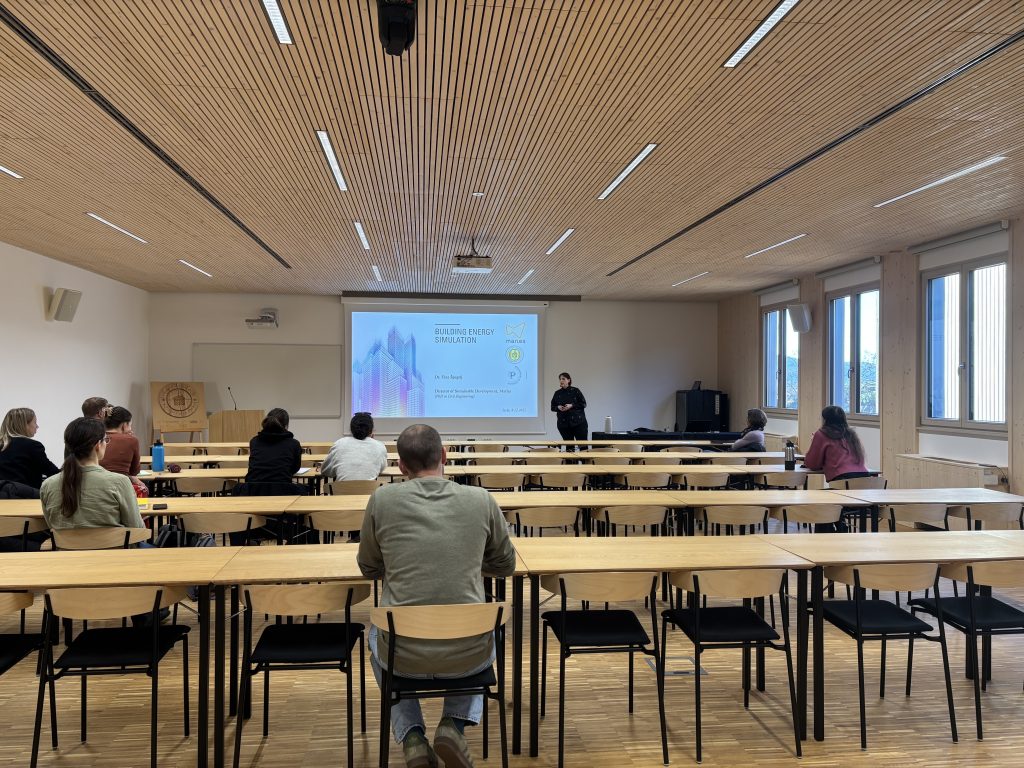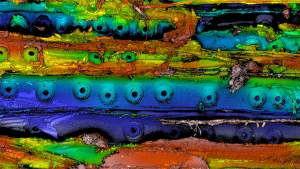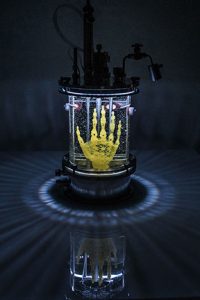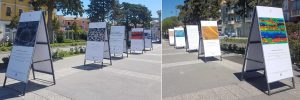
December 10, 2025

It happened while working on the online article “Smart textiles”; when it was almost prepared for publishing, the only thing missing was a suitable cover photo. Laetitia Marrot suggested that some of her images made during her research work might come into play.
The look on her screen was almost stunning, and the dilemma regarding the cover photo was immediately resolved. The shots were hypnotic and beautiful, with variations like an art series from an art exhibition. What an effect it would be to see such images in a large format!
That’s how it started. The InnoRenew CoE team –Lea Primožič, Amy Simmons, Liz Dickinson, Gertrud Fábián, Julija Uršič – came up with the concept: a selection of images taken by researchers from the institute during their work, printed on outdoor boards so they could be seen by as many people as possible. On each panel, a QR code connects viewers to an online exhibition that runs parallel to the outdoor exhibition where viewers can vote for their favourite picture.

A microscopic image of pine sapwood roughness is currently leading in the voting. Photo: Faksawat Poohphajai, Anna Sandak, Jakub Sandak
Starting idea: A majority of viewers won’t know what a particular picture shows. But because the images are both unusual and very aesthetic, they will attract viewers, who will become curious. What does this picture represent? And then, by getting the information, viewers will probably be surprised to find out that the picture is not related to art but belongs to science.
This is the way to build a bridge to science, which contains some elements that are characteristic of art: the art exhibition form, the aesthetic dimension, the factor of surprise. In this case, of course, we cannot talk about art, although the images of the researchers’ pictures encourage us to think in this direction. One of the reasons for thoughts like this can be traced to the rise of art that directly involves science in the creative process or refers to it and is in dialogue with it, which began in the 1990s. The result of these reflections, which will raise questions about the frameworks of science even more clearly, may be seen next year at the same time.

Amy Karle’s Regenerative Reliquary (2016) is an example of bioarts, which combines art, design, science and technology. Photo: Wikipedia Commons
Let us return now to the course of events. The team continued with determining the common thread of the exhibition – content that is invisible to the naked eye and related to research into wood and other renewable materials – and the number of exhibited pictures. The researchers’ response to participate and submit images was very good; each picture or series of pictures grew the enthusiasm associated with surprise and wonder. Images taken during research with computer programs or laboratory devices (optical and electron microscopes, spectrometers, thermal camera, computed tomography) show extraordinary colours, compositions and structures. To the layman, they may really seem like an artistic abstraction, play of patterns or even a fantastic landscape.
The “genre” diversity of the images can be attributed to the interdisciplinary nature of research at InnoRenew CoE. Images were created on quite different occasions, such as testing optimal surface roughness for the bio-based coating system with living organisms being investigated by researchers. By the way, the image made during this research is currently leading the online exhibition voting results for favorite picture.
Other images were made during research on gluebond quality of Douglas-fir plywood, in the research project on yellow-poplar CLT adhesion properties and in investigation of the effects of Generally Recognised as Safe (GRAS) compounds on the growth of mould on Scots pine wood surface.
There were also shots made for identifying wood species using its microscopic anatomy, computer projections that should contribute to the understanding of paracrystalline cellulose behavior when subjected to various loads using amorphous and crystalline cellulose substrates – all the way to the image taken in the Postojna forests during the selection of logs from which boards were to be cut and some other measurements were to be made.
When the Municipality of Izola recognized the value of the event, the open-air exhibition was made possible and it became clear that the whole idea would be realized.

Locals and tourists could see the outdoor exhibition on Sončni breg in Izola from 10 to 31 July 2020. Photo: Lea Primožič
The final appearance of the exhibition was shaped by the architect Eva Prelovšek Niemelä, who designed the layout of the boards that were set up in Izola with the help of technicians Josip Dijanić and Miladin Jokić. The online exhibition was organized by information technology specialist Tine Šukljan, including the voting that will be closed in early September. So far, the pictures have received more than 180 votes, but there is still time. Readers are invited to visit the page and vote.
In addition to the Municipality of Izola, the exhibition was made possible by the Izola Centre for Culture, Sport and Events, Tourist Association Izola and Ministry of Economic Development and Technology – Wood Industry Directorate. We thank all of the sponsors for their support.